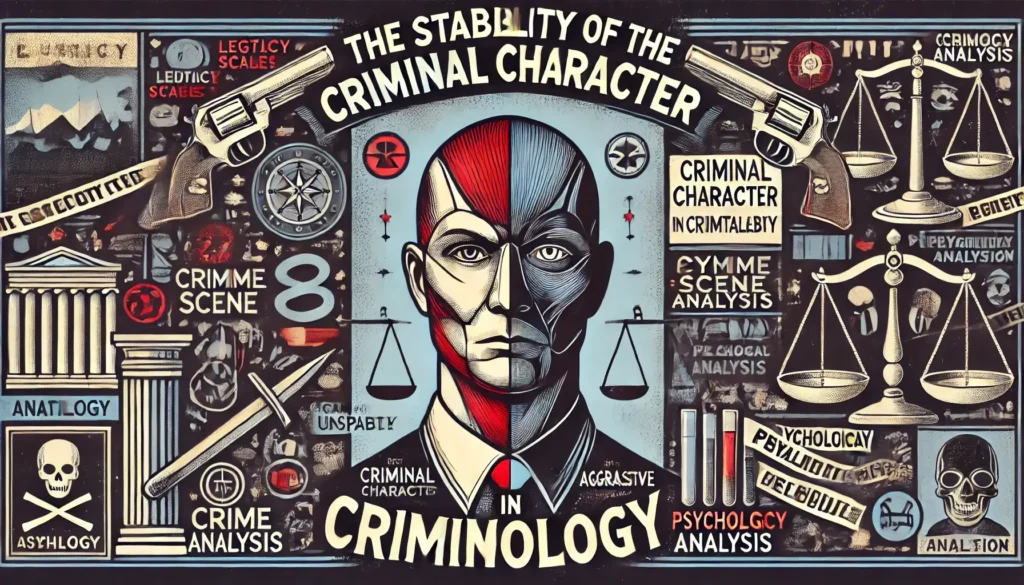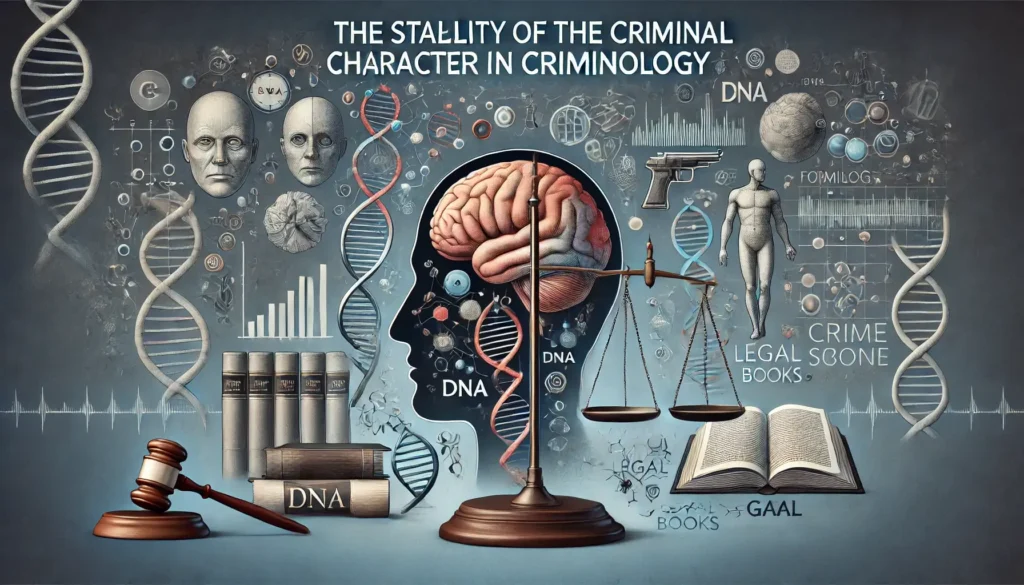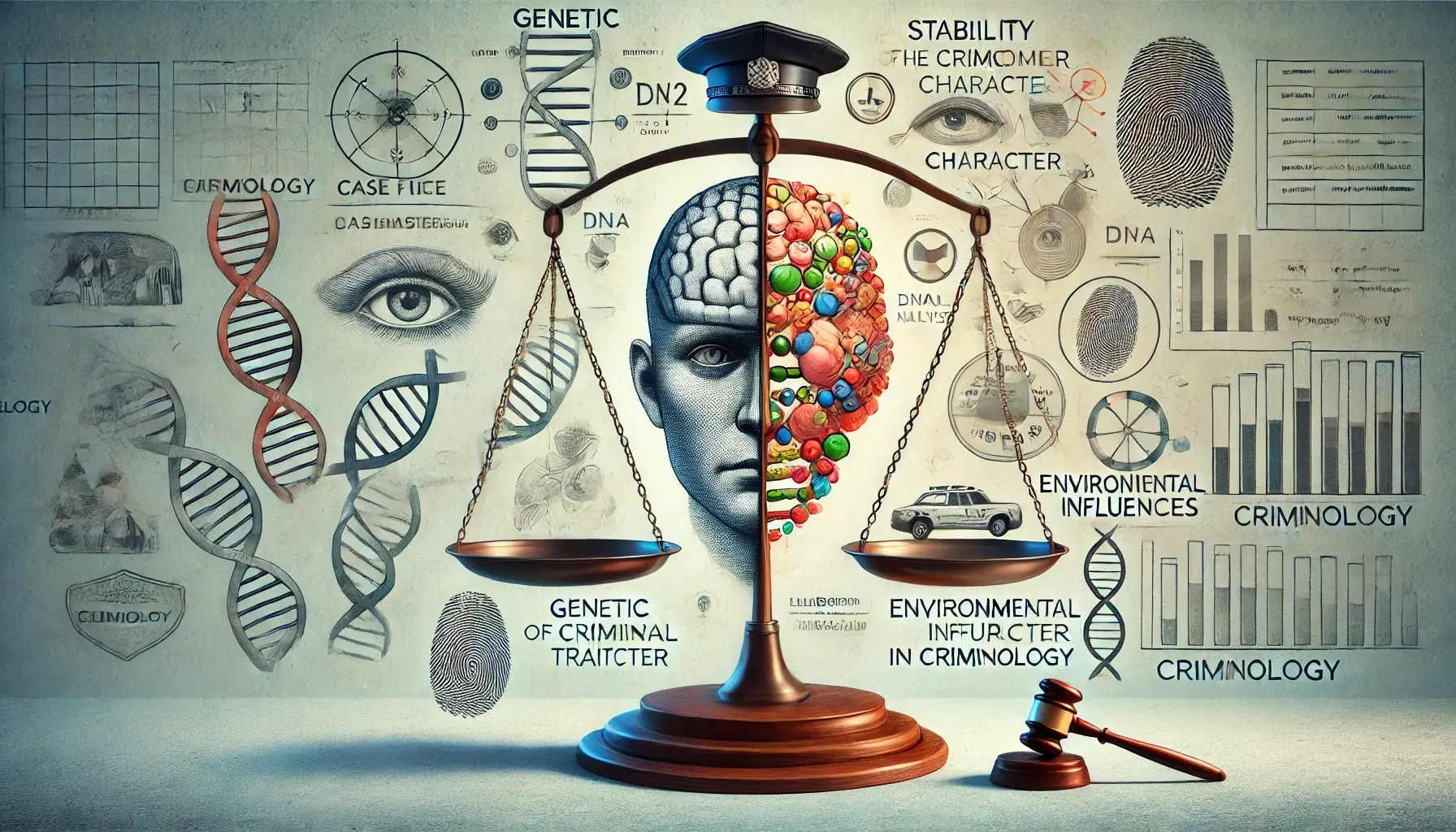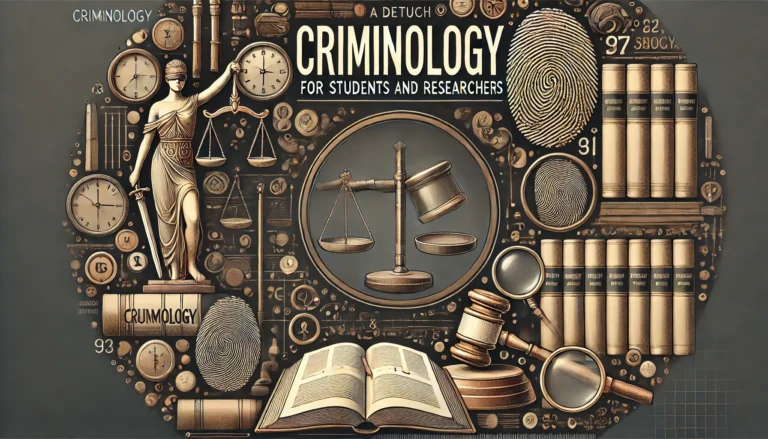The Stability of the Criminal Character in Criminology: Exploring the Roots of Persistent Criminal Behavior
Introduction: Defining the Criminal Character in Criminology
The study of criminology encompasses a wide range of topics, one of the most intriguing being the concept of the criminal character. Understanding the stability of the criminal character is crucial for criminologists, as it helps explain why certain individuals engage in criminal behavior over time, while others do not. The term “criminal character” refers to a set of psychological, social, and behavioral traits that predispose an individual to commit crimes. These traits may remain stable throughout a person’s life, influencing their involvement in criminal activities.
This article aims to explore the stability of the criminal character, examining the factors that contribute to its persistence or change. By analyzing various criminological theories and case studies, we will assess whether criminal behavior is a result of stable traits or whether it can be influenced by external circumstances. Furthermore, we will investigate how criminology helps understand this concept, the implications it has for the criminal justice system, and the potential for rehabilitation or prevention.
1. Understanding the Concept of Criminal Character in Criminology
The concept of criminal character has been a central topic in criminology for decades. It refers to the enduring traits and dispositions that influence an individual’s likelihood of engaging in criminal behavior. The stability of these traits is debated in criminological circles, with some arguing that criminal tendencies are innate, while others suggest that they are shaped by environmental factors.
Criminologists have long been interested in understanding the nature of criminal character and its implications for society. Various theories have emerged over time, each offering a unique perspective on why some individuals develop a criminal character. Some theories emphasize the role of biology and genetics, while others focus on psychological and social factors. Understanding the stability of criminal character is essential for criminologists, as it can help identify potential offenders and develop effective interventions.
2. Theories of Stability in Criminal Behavior
Criminologists have proposed several theories to explain the stability of criminal behavior. These theories can be broadly categorized into biological, psychological, and sociological perspectives, each offering insights into why certain individuals exhibit criminal tendencies throughout their lives.
Biological Theories: Genetics and Criminal Tendencies
Biological theories suggest that criminal behavior may be rooted in an individual’s genetic makeup. Researchers have studied the link between genetics and criminality, examining whether certain inherited traits predispose individuals to engage in criminal activities. Some studies have found a correlation between genetic factors and criminal behavior, while others argue that the environment plays a more significant role.
Psychological Theories: Personality Disorders and the Criminal Mind
Psychological theories focus on the mental and emotional traits that contribute to criminal behavior. For instance, individuals with personality disorders such as antisocial personality disorder or narcissistic personality disorder may be more prone to criminal behavior. These theories argue that criminality is often a result of dysfunctional psychological development, leading to unstable emotional states and poor decision-making skills.
Sociological Theories: Social Environments and Their Impact on Criminal Behavior
Sociological theories emphasize the role of social environments in shaping criminal behavior. These theories suggest that individuals who grow up in disadvantaged or criminogenic environments are more likely to develop a criminal character. Factors such as poverty, peer influence, and exposure to crime can significantly impact an individual’s likelihood of engaging in criminal activities. This perspective argues that criminal character is not solely the result of internal traits but also influenced by external circumstances.

3. Stability of the Criminal Character: Key Factors
Several key factors contribute to the stability of criminal character, including genetic predispositions, environmental influences, and psychological traits. These factors interact in complex ways, and their influence on criminal behavior can vary from person to person.
Genetic Predispositions: How Nature vs. Nurture Influences Criminality
One of the most debated topics in criminology is the nature versus nurture debate. Are individuals born with a predisposition to commit crimes, or are their criminal behaviors shaped by their environment? Research has shown that both genetic and environmental factors play a role in shaping criminal character. While some individuals may inherit certain traits that increase their likelihood of engaging in criminal activities, external factors such as family dynamics and socialization also play a crucial role.
Environmental Factors: The Role of Upbringing, Peer Influence, and Society
Environmental factors are often cited as significant contributors to the stability of criminal character. For example, individuals who grow up in environments characterized by neglect, abuse, or exposure to criminal activity may be more likely to develop a criminal character. Peer influence also plays a significant role, as individuals may adopt criminal behaviors to fit in with their social group.
Psychological Traits: The Role of Personality Disorders and Mental Health
Psychological traits, such as personality disorders and mental health conditions, can contribute to the stability of criminal character. Individuals with certain psychological conditions may struggle with impulse control, empathy, and moral reasoning, increasing their likelihood of engaging in criminal activities. These traits may remain stable over time, further reinforcing the individual’s criminal behavior.
4. The Role of Criminology in Understanding Criminal Character
Criminology plays a crucial role in understanding the stability of the criminal character. By examining criminal behavior through various theoretical frameworks and empirical research, criminologists aim to identify the underlying causes of crime and the extent to which certain individuals are predisposed to criminal be²havior over time. Understanding the stability of criminal character helps criminologists develop more effective theories for crime prevention, rehabilitation, and intervention.
How Criminology Helps Explain the Stability of Criminal Character
Criminology examines both the individual and societal factors that contribute to criminal behavior. By integrating biological, psychological, and sociological perspectives, criminologists can offer a more comprehensive understanding of why some individuals exhibit stable criminal tendencies throughout their lives. The study of criminal character allows criminologists to identify patterns and characteristics that may signal a predisposition to criminal behavior, helping law enforcement agencies and policymakers intervene more effectively.
Theories and Frameworks Used by Criminologists to Study Stable Criminal Behaviors
Several theories and frameworks are used by criminologists to study the stability of criminal character. These include:
- Theories of Genetic Predisposition: Criminologists examine the potential genetic factors that contribute to criminal behavior, looking at genetic markers or family histories of criminality.
- Psychological Theories of Stability: These theories focus on the mental and emotional traits that may cause an individual to engage in persistent criminal activities, such as personality disorders, aggression, or lack of empathy.
- Social Learning Theories: Social learning theory posits that criminal behavior is learned through interactions with others, and stable criminal tendencies may arise from long-term exposure to criminal environments or behaviors.

Case Studies and Criminological Research Supporting the Concept of Stability in Criminal Character
Numerous criminological studies and case research have supported the idea that criminal behavior can be stable over time. One of the most significant pieces of evidence comes from longitudinal studies that track individuals over extended periods. These studies show that some individuals who engage in criminal activities during adolescence continue to do so into adulthood, suggesting that their criminal character may be stable.
For example, research on repeat offenders demonstrates that criminality can persist despite interventions. Understanding the stability of criminal character allows criminologists to determine the most effective methods for breaking the cycle of criminal behavior, including the development of tailored rehabilitation programs.
5. The Stability of the Criminal Character: Nature vs. Nurture Debate
The debate between nature and nurture has long been central to discussions about the stability of the criminal character. Is criminality an inherent trait, or is it shaped by an individual’s environment and experiences? This section will explore both sides of the debate and consider how each perspective influences our understanding of criminal behavior.
The Ongoing Debate: Is Criminality Innate or Shaped by External Factors?
The “nature versus nurture” debate has led to conflicting viewpoints about the stability of criminal character. On one side, proponents of biological theories argue that certain individuals may be born with a predisposition to commit crimes due to their genetic makeup. On the other side, sociological theories emphasize that an individual’s upbringing, social environment, and life experiences significantly influence their likelihood of engaging in criminal behavior.
Studies supporting the biological perspective suggest that genetic factors may predispose individuals to exhibit antisocial traits or a lack of impulse control, which can lead to criminal behavior. Meanwhile, sociological studies focus on the impact of negative social environments, such as poverty, family dysfunction, and exposure to violence, as primary contributors to criminal tendencies.
Review of Research that Supports Both Sides of the Debate
Research has provided evidence to support both perspectives. For example, twin and adoption studies have shown that genetic factors may play a role in the development of criminal behavior, with identical twins exhibiting similar criminal tendencies despite being raised in different environments. Additionally, studies have demonstrated that children raised in environments characterized by abuse, neglect, or violence are more likely to engage in criminal behavior later in life.
Despite these findings, it is essential to note that most criminologists agree that criminal behavior is the result of a complex interaction between genetic predispositions and environmental influences. The stability of criminal character may be influenced by both nature and nurture, with different individuals exhibiting different patterns of stability based on their unique circumstances.

6. Assessment and Measurement of Criminal Character Stability
Understanding and measuring the stability of criminal character is a significant challenge for criminologists. The complex nature of human behavior, combined with the numerous factors that influence criminality, makes it difficult to accurately assess the stability of criminal tendencies over time.
Methods Used in Criminology to Assess Criminal Tendencies
Criminologists use a variety of methods to assess the stability of criminal behavior. These methods include:
- Psychological Assessments: Standardized tests and interviews are used to evaluate personality traits, emotional states, and psychological disorders that may contribute to criminal behavior.
- Behavioral Observation: Observing an individual’s behavior over time allows criminologists to identify patterns that may indicate a stable criminal character. This method is often used in longitudinal studies.
- Criminal History Analysis: Reviewing an individual’s past criminal record can provide insight into the stability of their criminal behavior. Repeat offenses and patterns of recidivism are often seen as indicators of stable criminal tendencies.
The Challenges in Measuring the Stability of Criminal Character
Measuring the stability of criminal character is complicated by various factors. For instance, some individuals may engage in criminal behavior due to temporary circumstances, such as financial hardship or peer pressure, rather than an inherent criminal character. Additionally, interventions such as rehabilitation programs may alter an individual’s behavior, making it challenging to determine whether the change is temporary or permanent.
Another challenge in measuring criminal character stability is the subjective nature of psychological assessments and behavioral observations. Different criminologists may interpret the same data in varying ways, leading to inconsistencies in conclusions about the stability of criminal behavior.
7. The Role of Rehabilitation and Intervention in Changing Criminal Character
One of the key questions in criminology regarding the stability of criminal character is whether criminal tendencies can be changed through rehabilitation or intervention. If criminal character is indeed stable, does that mean that criminals are beyond reform, or can their behavior be modified through targeted programs and strategies? This section will explore the potential for rehabilitation and intervention to alter criminal character and reduce recidivism.
The Impact of Rehabilitation Programs on Criminal Character
Rehabilitation programs aim to address the underlying causes of criminal behavior and promote behavioral change. These programs often focus on improving cognitive skills, emotional regulation, and social functioning, with the goal of reducing criminal tendencies. Research suggests that rehabilitation can be effective in changing criminal behavior, particularly when programs are tailored to the individual’s specific needs.
For example, cognitive-behavioral therapy (CBT) has been shown to help individuals recognize and change the thought patterns that lead to criminal behavior. Other programs, such as anger management or substance abuse treatment, focus on addressing specific issues that may contribute to criminal tendencies.
However, the effectiveness of rehabilitation depends on various factors, including the nature and severity of the criminal behavior, the individual’s willingness to change, and the quality of the intervention program. Some criminologists argue that individuals with deeply ingrained criminal traits may be less responsive to rehabilitation, while others suggest that with the right intervention, even individuals with stable criminal tendencies can change.

The Challenges of Changing a Stable Criminal Character
While rehabilitation programs have been shown to be effective in some cases, there are challenges in changing a stable criminal character. For individuals with personality disorders, antisocial traits, or a long history of criminal behavior, the process of change can be particularly difficult. The stability of their criminal tendencies may make them less receptive to intervention, and they may continue to engage in criminal activities despite attempts at rehabilitation.
Additionally, external factors such as the individual’s social environment, peer relationships, and economic circumstances can influence the success of rehabilitation programs. For instance, an individual may be rehabilitated in prison but may return to a criminogenic environment upon release, which could increase the likelihood of reoffending.
The Role of Early Intervention in Preventing Criminal Behavior
Early intervention programs aimed at children and adolescents are another way to address the stability of criminal character before criminal behavior becomes ingrained. These programs focus on preventing the development of criminal tendencies by providing support and guidance to at-risk youth. Early intervention may involve addressing factors such as poor academic performance, exposure to violence, or family dysfunction, which can increase the likelihood of future criminal behavior.
Research has shown that early intervention programs can be effective in reducing the risk of criminal behavior later in life, particularly when they are implemented during critical developmental periods. By providing positive role models, teaching coping skills, and promoting social integration, early intervention can help individuals develop healthier coping mechanisms and reduce their likelihood of engaging in criminal activities.
8. Social Implications: How the Stability of Criminal Character Affects Society
The stability of the criminal character has significant social implications, both for individuals and for society as a whole. Understanding the factors that contribute to the persistence of criminal behavior can help policymakers, law enforcement, and the criminal justice system address crime more effectively.
Impact on Crime Prevention and Law Enforcement Strategies
The stability of criminal character informs crime prevention and law enforcement strategies. If criminal behavior is stable and predictable, law enforcement agencies can take proactive steps to identify and intervene with potential offenders before they commit crimes. This could involve increased surveillance in high-risk areas, targeted interventions for individuals at risk, and more focused crime prevention programs.
Additionally, understanding the stability of criminal character allows law enforcement agencies to better allocate resources to the individuals and communities most in need of intervention. By focusing on individuals with stable criminal tendencies, law enforcement can work to prevent future crimes and reduce the overall crime rate.
Impact on Policy and Criminal Justice Practices
The concept of a stable criminal character also influences criminal justice policies, particularly with regard to sentencing and rehabilitation. If criminologists and policymakers recognize that some individuals may have a more stable criminal character, they may develop policies that focus on long-term rehabilitation and reintegration into society. This could include more individualized rehabilitation programs, vocational training, and support networks to help offenders reintegrate successfully into society.
On the other hand, if criminal behavior is seen as being primarily a result of external factors such as poverty or social disadvantage, policies may focus more on addressing the root causes of crime rather than focusing solely on the individual. This could lead to policies that focus on improving social services, education, and job opportunities to prevent crime from occurring in the first place.
9. Future Directions: Exploring the Evolution of the Concept of Criminal Character
As criminology continues to evolve, the understanding of criminal character and its stability will likely change. Advances in neuroscience, psychology, and sociology may offer new insights into the nature of criminal behavior and the factors that contribute to its stability over time.
Emerging Research in Neuroscience and Its Impact on Criminal Character
Neuroscientific research has begun to provide new perspectives on the stability of criminal character, particularly in relation to brain function and structure. Studies have shown that individuals with certain brain abnormalities or dysfunctions may be more prone to impulsive behavior, aggression, and criminal tendencies. This emerging research may provide more concrete evidence of the biological underpinnings of criminal behavior and help identify early indicators of individuals at risk.
The Role of Technology in Monitoring and Understanding Criminal Behavior
Advancements in technology, such as artificial intelligence and data analysis, may also play a significant role in understanding the stability of criminal character. By analyzing vast amounts of data, criminologists can gain new insights into patterns of criminal behavior, risk factors, and the effectiveness of intervention programs. Predictive modeling and risk assessment tools may help identify individuals at higher risk of reoffending, allowing for more targeted interventions.
The Future of Rehabilitation and Crime Prevention
The future of rehabilitation and crime prevention will likely be influenced by new approaches that integrate psychological, social, and technological interventions. Personalized rehabilitation programs that account for an individual’s unique psychological traits, social environment, and genetic predispositions may become more common, offering a more holistic approach to crime prevention.
Conclusion:
In conclusion, the concept of the stability of the criminal character in criminology is a complex subject, involving various psychological, social, and biological factors. By exploring the elements that contribute to the persistence of criminal behavior, it becomes clear that the interaction between nature and nurture plays a significant role in shaping the criminal character. While some aspects of criminal behavior may remain stable, interventions and rehabilitation programs can still effect change, especially when tailored to meet individual needs.
Furthermore, recent advancements in criminology provide hope for improved crime prevention policies and strategies through a deeper understanding of the role of criminal character stability. With ongoing research and technological advancements, we can develop new methods for predicting and addressing criminal behavior more effectively.
Ultimately, the evidence suggests that the criminal character is not necessarily a fixed trait, but one influenced by multiple factors. This necessitates a comprehensive approach in dealing with individuals displaying criminal behavior. Through such a holistic perspective, society can strive to reduce crime and offer opportunities for healing and transformation for those involved.

The reviewer
- Character Development and Criminology
This paper discusses the development of character and its relation to criminology. - The Stability of Antisocial and Delinquent Child Behavior: A Review
A review on the stability of antisocial and delinquent behavior in children. - The Lombrosian Myth in Criminology
A critique of Lombroso’s theory on the criminal character in criminology.







